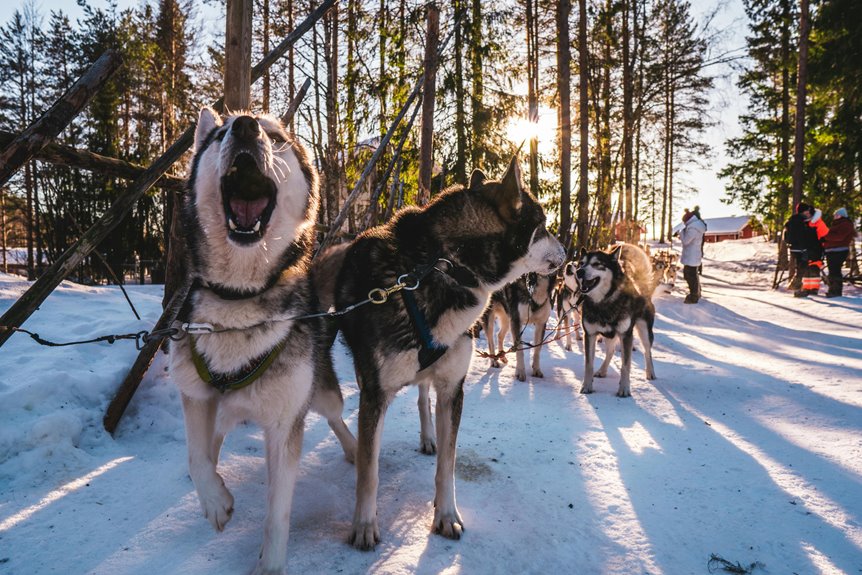25 Best Packing Tips for Cold Weather Travel

You’re planning a cold weather trip, and packing smartly makes all the difference in staying warm and ready. Start by layering your clothes for maximum warmth, then pick moisture-wicking base layers and thermal essentials. These strategies keep you comfortable, but you’ll want to explore how they save space and boost efficiency.
Layer Your Clothing for Maximum Warmth
Beat the chill by layering your clothing to trap heat efficiently and adapt to fluctuating temperatures.
Master Layer Sequencing by starting with a light base, adding insulating mid-layers, and finishing with a windproof outer layer.
For Activity Adaptation, you adjust layers dynamically; remove one during hikes to avoid sweating, then add back when resting to maintain warmth without bulk.
Choose the Right Base Layers
When you’re preparing for cold weather travel, choose base layers that effectively wick moisture away from your skin to keep you dry and prevent heat loss.
Opt for eco materials like merino wool or bamboo to minimize environmental impact and enhance comfort.
For fashion coordination, select neutral colors and versatile fits that effortlessly match your outerwear, creating a cohesive, stylish look while prioritizing practicality and warmth.
Pack Thermal Underwear Essentials
Thermal underwear forms the core of your cold weather layering system, so select pieces that offer superior insulation and moisture management for extended comfort.
You’ll appreciate design innovations like advanced moisture-wicking fabrics that enhance mobility without bulk.
Don’t ignore the environmental impact; opt for items made from recycled materials to reduce waste, ensuring your packing is sustainable and practical for chilly adventures.
Select Insulated Jackets and Coats
Insulated jackets and coats form the outer layer of your cold weather ensemble, shielding you from elements like wind and snow while maintaining mobility.
When you select one, evaluate fabric types such as down for lightweight warmth or synthetic for water resistance and easy packing.
For color choices, pick darker shades to hide dirt on trips or brighter options for visibility in snowy environments, ensuring you’re practical and prepared.
Include Waterproof Gloves and Mittens
Beyond your jacket’s protection, you’ll need waterproof gloves or mittens to safeguard your hands from wet conditions and freezing temperatures.
When selecting, explore diverse Glove Fashions that offer finger mobility for tasks, or Mitten Designs with insulated layers for enhanced warmth.
These choices keep your hands dry in snow or rain, ensuring dexterity and comfort during activities.
Don’t Forget Hats and Beanies
Why not top off your cold weather gear with a hat or beanie to keep your head protected?
You’ll retain heat effectively by exploring various hat styles that suit your activities, while staying current with beanie trends guarantees both warmth and flair.
- Experiment with hat styles like ear-flap designs for extra coverage.
- Follow beanie trends with moisture-wicking fabrics for active outings.
- Choose adjustable hat styles to fit under hoods seamlessly.
- Select the latest beanie trends featuring insulated linings for harsh winds.
Add Scarfs or Neck Gaiters
Complement your hats with scarfs or neck gaiters to cover your neck and trap body heat during chilly adventures.
Explore scarf fashion for versatile styles that layer easily over coats, adding flair without extra bulk.
Stay ahead of gaiter trends; they’re lightweight, adjustable protectors against wind, and double as face covers, ensuring you pack smartly for varied cold-weather outings.
Invest in Sturdy Waterproof Boots
Protect your feet from the elements by investing in sturdy waterproof boots, which shield you from snow, slush, and puddles while providing essential traction on slippery surfaces.
When you’re choosing boots, focus on boot materials for weather resistance and opt for trail boots to handle tough terrain.
- Evaluate boot materials like leather or Gore-Tex for durability and waterproofing.
- Choose trail boots with reinforced soles for superior grip on icy paths.
- Make sure your boots feature insulated linings to maintain warmth without bulk.
- Test trail boots for a snug fit to prevent discomfort during long walks.
Stock Up on Warm, Moisture-Wicking Socks
Just as sturdy boots guard your feet against the cold, you’ll need to stock up on warm, moisture-wicking socks to keep them dry and comfortable on your travels.
In cold conditions, opt for Merino Socks that efficiently wick moisture and provide excellent warmth.
Don’t overlook Compression Benefits, which improve blood flow, reduce fatigue, and help keep your feet energized during extended adventures.
Bring Hand and Foot Warmers
As you head into freezing conditions, hand and foot warmers offer a simple yet effective way to keep your extremities cozy.
- You’ll activate them using methods like air exposure or shaking for quick readiness.
- Check warmth duration; many last 6–12 hours to maintain comfort during long outings.
- Pack a few per day to guarantee you stay warm in variable cold weather.
- Choose types that fit discreetly in gloves or shoes for maximum practicality.
Opt for a Versatile Travel Backpack
When you’re planning cold weather travel, a versatile travel backpack serves as your reliable companion for hauling essentials.
Explore backpack styles like internal frame designs for stability or external options for easy access during treks.
For material choices, select durable, weather-resistant fabrics such as nylon or polyester that repel moisture, ensuring your gear stays dry and secure in harsh conditions.
Use Packing Cubes to Organize Gear
Streamline your packing with cubes to keep your cold weather gear neatly organized and easy to access.
You’ll love how cube materials like durable, water-resistant nylon protect your items from snow and dampness.
Opt for custom designs to tailor cubes to your backpack’s dimensions for maximum efficiency.
- Choose cube materials that withstand cold temperatures for long-lasting use.
- Select custom designs to categorize gear like hats and gloves effectively.
- Make sure cubes are compressible to save space in your pack.
- Label custom designs for quick retrieval during your adventures.
Roll Clothes Instead of Folding Them
Instead of folding your clothes the traditional way, roll them to squeeze more into your pack and minimize wrinkles on the go.
Rolling enhances wrinkle prevention by keeping fabrics smooth and compact, avoiding deep creases during transit.
This boosts travel efficiency, letting you fit more essentials without overloading your bag, so you’re always organized and prepared for cold adventures.
Pack Lightweight Yet Warm Accessories
While you’ve optimized space by rolling your clothes, you can’t overlook accessories that deliver warmth without the extra weight.
To keep things practical, incorporate smart fabric choices like merino wool and follow design trends for sleek, functional options.
- Opt for hats with lightweight fabric choices that trap heat efficiently without bulk.
- Choose gloves reflecting modern design trends, like touchscreen-compatible seams for ease.
- Select scarves from breathable fabrics that incorporate minimalist designs for layered versatility.
- Pick beanies with compact design trends, ensuring they fold flat while retaining warmth.
Include a Compact First Aid Kit
When traveling in cold weather, you’ll want to prioritize safety by packing a compact first aid kit that fits easily into your luggage.
Include aid essentials such as bandages, pain relievers, and antiseptics to handle minor injuries or illnesses.
For kit customization, tailor it to your trip by adding cold-specific items like blister treatments or altitude aids, ensuring you’re prepared without added bulk.
Add Sunscreen for Snowy Conditions
Beyond your first aid kit, snow’s reflective surface intensifies the sun’s rays, so you’ll need to pack sunscreen for your trip.
This protects against UV Reflection and prevents Snow Blindness, ensuring safer outdoor adventures.
- Choose sunscreen with SPF 50+ to counter UV Reflection effectively.
- Apply generously before exposure to avoid Snow Blindness.
- Reapply every two hours during snowy activities.
- Opt for water-resistant formulas for prolonged protection.
Don’t Overlook Lip Balm and Moisturizer
Lip balm and moisturizer are must-haves for cold weather travel, as harsh winds and low humidity can quickly dry out your skin and lips.
For effective lip protection, choose a balm with SPF and apply it frequently to guard against chapping.
Prioritize skin hydration by packing a lightweight, non-greasy moisturizer that keeps your face and hands moisturized, preventing irritation so you stay comfortable on the go.
Carry an Emergency Thermal Blanket
One essential item you shouldn’t overlook is an emergency thermal blanket, which packs down small yet provides crucial warmth in cold weather mishaps.
It’s ideal for emergency uses and offers alternatives to bulkier options.
- Use it for emergency uses like shielding from wind or signaling for help.
- Compare blanket alternatives, such as fleece liners, but choose the compact thermal for space-saving.
- Pack one in your bag to handle unexpected exposure quickly.
- Make sure it serves as a lightweight backup when regular blankets fail in travel.
Bring a Portable Phone Charger
While you’re packing that emergency thermal blanket for unexpected cold, you’ll also need a portable phone charger to keep your device powered during travel.
In chilly conditions, batteries drain faster, so always check phone compatibility to guarantee it works with your model.
Opt for a charger with excellent durability to handle rough trips, preventing failures and keeping you connected when it matters most.
Choose Multi-Purpose Travel Items
Because cold weather travel often demands packing light, you’ll find that selecting multi-purpose items maximizes space and versatility in your gear.
Incorporating Versatile Gadgets and Multi Tool Essentials streamlines your setup.
- Choose a multi-tool that acts as a knife, screwdriver, and repair aid—your essential Multi Tool Essential.
- Select a scarf that doubles as a hat and face cover for cold protection.
- Pack Versatile Gadgets like a blanket serving as a jacket liner.
- Opt for gloves that convert to mittens, blending warmth and Multi Tool Essentials functionality.
Pack Reusable Water Bottles
Pack a reusable water bottle to stay hydrated on your cold weather adventures, especially since freezing temperatures can dehydrate you faster than you realize.
You’ll gain hydration benefits like improved energy and warmth, helping you perform better in the cold.
Plus, it cuts down on environmental impact by reducing single-use plastic waste, making your travels more eco-friendly and practical.
Include High-Energy Snacks
Energize your cold weather travels by packing high-energy snacks that deliver a quick boost of fuel.
These help you maintain warmth and stamina on the go.
- Pack Energy Bars for compact, nutrient-rich fuel that revs up your energy quickly.
- Include Trail Mix, blending nuts and dried fruits for sustained, balanced calories.
- Opt for protein-packed options like jerky to fend off fatigue in chilly conditions.
- Choose non-perishable snacks that fit easily in your pack without adding bulk.
Protect Essentials in Waterproof Bags
Safeguard your essential items from moisture and cold weather surprises by stashing them in waterproof bags.
You’ll easily handle jewelry waterproofing by sealing rings and necklaces to prevent tarnish and damage during wet conditions.
For medicine protection, pack pills and creams securely to avoid humidity, keeping them potent for your travels.
This smart strategy guarantees quick access and peace of mind.
Stock Extra Batteries for Devices
While you’ve safeguarded your essentials against moisture, cold weather can quickly sap the power from your devices.
So you’ll want extra batteries on hand to keep things running smoothly.
- Explore Battery Alternatives like portable chargers or solar options for reliable backups.
- Pack spares for cameras and phones to avoid downtime in freezing conditions.
- Follow proper Disposal Methods, such as recycling at designated facilities, to minimize environmental impact.
- Test batteries before your trip to verify they’re fully charged and functional.
Focus on Space-Saving Packing Techniques
To make the most of your luggage during cold weather trips, roll clothes instead of folding them—these bundles take up less room and minimize wrinkles.
You’ll love vacuum packing for bulky layers like sweaters, as it compresses them to free up space.
Don’t overlook modular storage; it lets you organize items into cubes, maximizing every inch and keeping your gear accessible.
Final Thoughts
With these 25 packing tips, you’re set to tackle cold weather travel like a pro. Layer your moisture-wicking bases, insulating mid-layers, and windproof outerwear for unbeatable warmth, then add thermal underwear, jackets, gloves, and boots to shield against the chill. Pack smart with cubes and eco-friendly gear, including snacks and batteries, so you stay energized and prepared. You’ll arrive comfortable, efficient, and ready for adventure—travel wisely and enjoy every moment!






